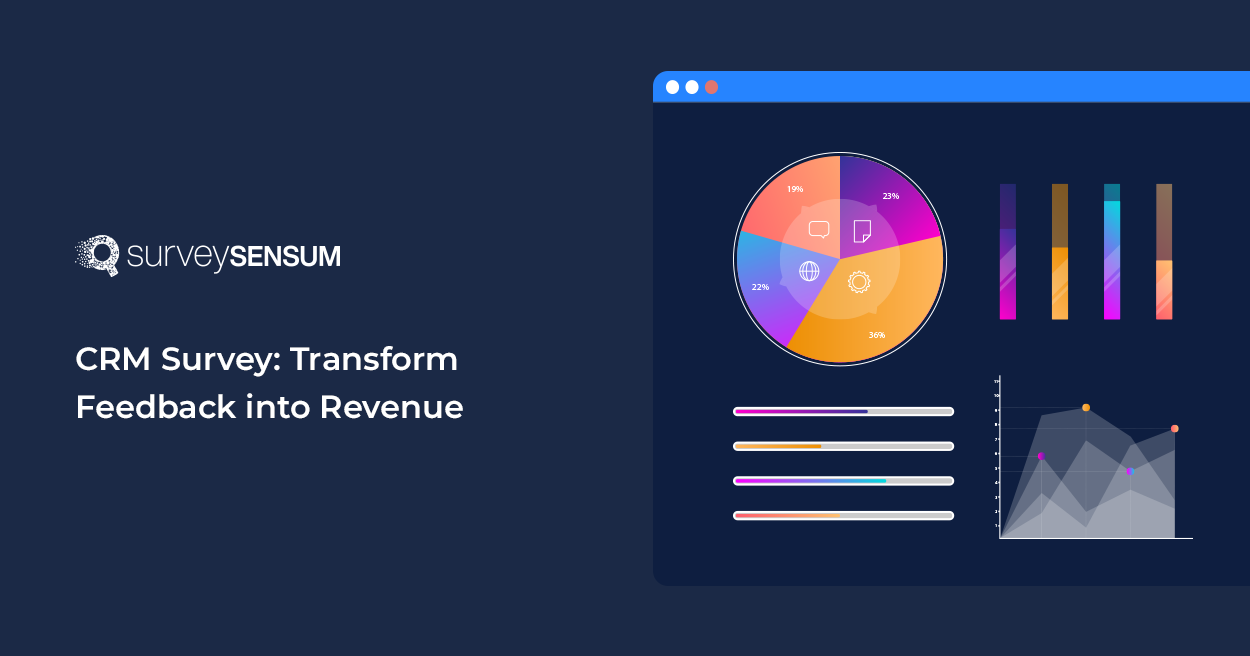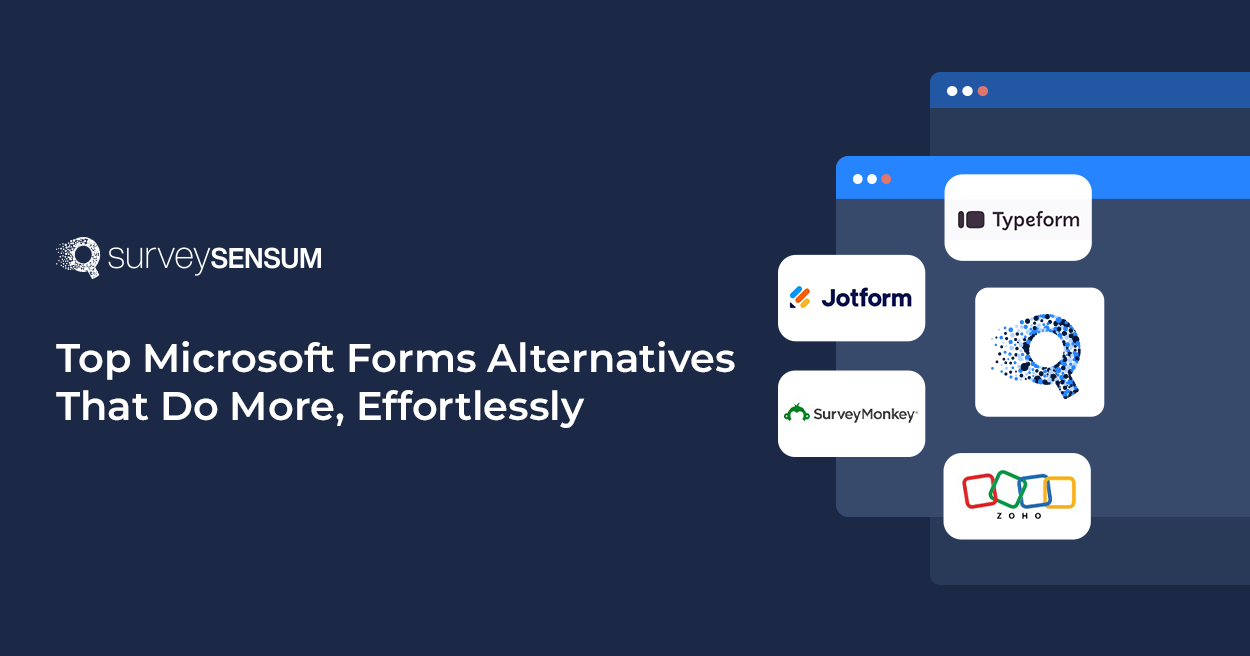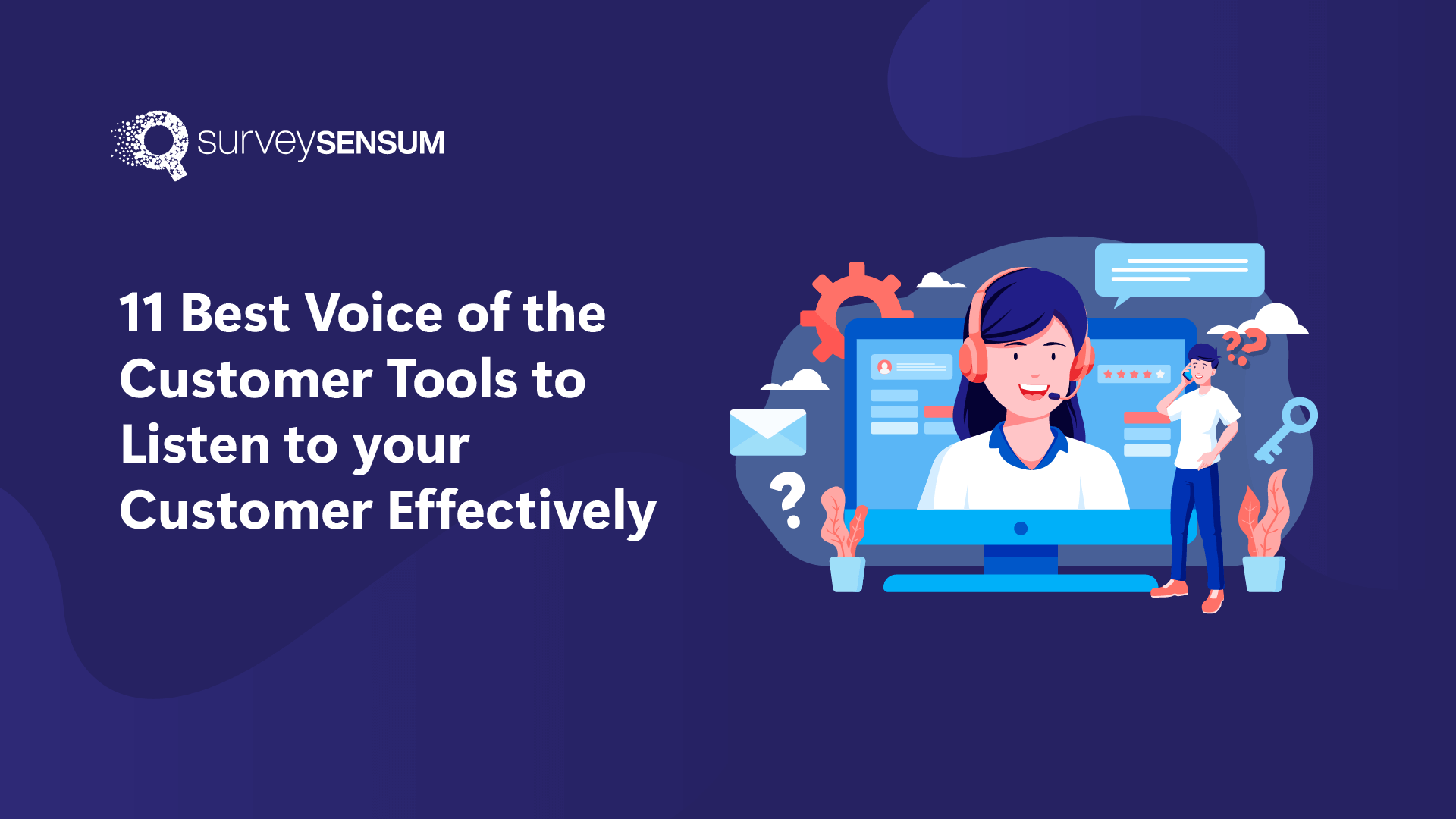
Your CRM is smart. But is it futuristic?
It knows your customers’ names, emails, and past purchases. But does it know what they actually want? What’s frustrating them? What will make them hit “buy” instead of bouncing to your competitor?
That’s where CRM surveys come in. Consider them as a straight line into the opinions of your consumers.
The result? Smarter marketing, better sales, and a customer experience that keeps people coming back.
In this blog post, we’re cracking the code on CRM surveys. Everything you need to convert your CRM into a data powerhouse – types, questions, use-cases, best practices, and more.
Let’s get started.
What is a CRM Survey?
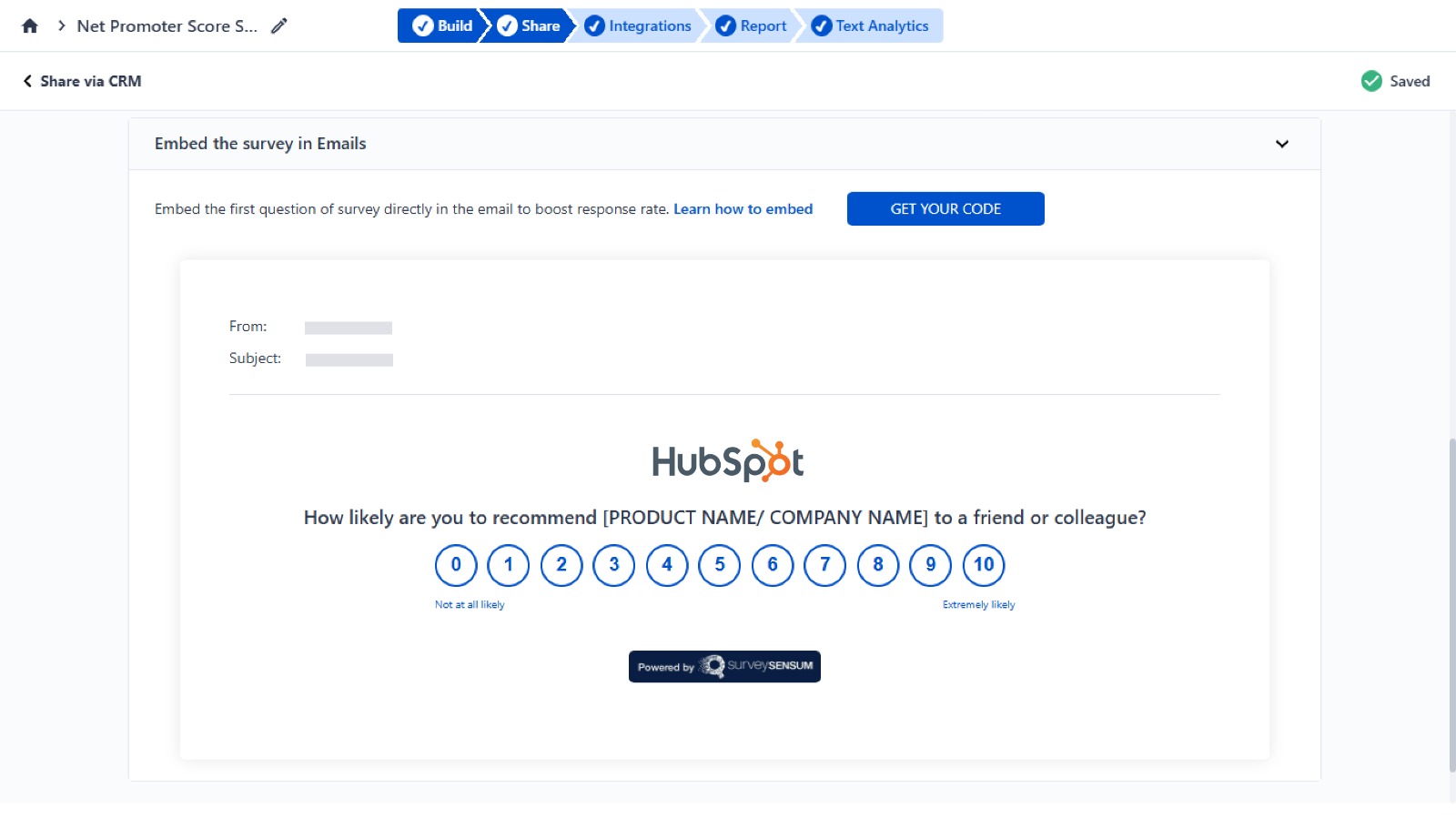
A Customer Relationship Management (CRM) survey is a targeted method of collecting customer feedback from the contacts stored in your CRM system. CRM surveys use existing customer data for personalized, context-driven questions. These surveys are sent at key touchpoints in your customer’s journey like, after support conversations, post-purchase, or throughout product use – they record real-time data that drives better decisions.
By integrating responses with CRM records, you can track sentiment, segment audiences, and automate follow-ups. Whether gauging NPS, CSAT, or product experience, CRM polls transform customer feedback into useful information guiding retention and development.
Alright, so we’ve covered what a CRM survey is, but you’re not here just for the what. You want to know why, so just scroll on.
Why CRM Surveys Are a Must-Have (Not Just a Nice-to-Have)
74% of CRM users say they unlock better access to customer data, while 64% swear by their power to level up relationship management.
Your company is a machine; your CRM system is the engine; however, without accurate, real-time customer insights, it will not function at maximum performance.
This is how CRM surveys can help save the day.
These surveys assist users in fine-tuning plans, increasing retention, and improving every CRM interaction. Here’s how.
1. Maintaining CRM Data Accuracy:
Your CRM only performs as good as the data it contains. Outdated or incomplete customer details lead to missed opportunities, irrelevant messaging, and poor customer experiences. Regular surveys help keep your database fresh by prompting customers to update their preferences, contact details, and purchase behaviors.
What does that mean for you? Accurate data powers smarter decisions – personalized sales outreach, targeted marketing interactions, and faster support experiences.
2. Data-Driven Segmentation and Personalization:
Nobody likes irrelevant emails or ads. CRM surveys give you insights enabling you to segment your customers based on real data – demographics, behavior, and preferences – so you can send campaigns that they can resonate with.
Result? That leads to more relevance, which results in increased engagement and elevated conversions. Simple math.
3. Making Smarter Business Decisions (Without the Guesswork!):
I’d say throwing darts in the dark is not a business strategy. Insights from the CRM surveys tell you what’s working, what’s not working, and where you’re leaving money on the table. If customers are confused by your pricing or frustrated by support, you’ll learn it before it costs you sales.
Now that we’ve cracked the code on why CRM surveys are a must-have, let’s explore the different types.
Types of CRM Surveys & Their Use Cases
When you leverage CRM surveys, you gain insights into different customer journey stages. Here’s a breakdown of each type, how they help you, and concrete examples of their use:
1. Customer Satisfaction Surveys (CSAT & NPS)
Would you like to find out whether clients simply endure you or love you?
Well, CSAT and NPS surveys are designed for just this.
– CSAT checks in on how happy a customer is right now – like after a support call or a purchase.
– NPS? That’s the big-picture loyalty test. It tells you if customers are sticking around for the long haul and if they’d actually recommend you.
CRM Surveys Questions for Measuring Customer Satisfaction
- On a 1–10 rating, how happy were you with today’s experience?
- On a scale of 0-10, how likely are you to tell a friend about our service?
How Feedback From These Questions Helps:
Because customers don’t always tell you when they’re unhappy – they just leave. These surveys provide clear, quantifiable comments that let you:
- Quantify customer sentiment with measurable insights
- Improve customer retention & advocacy
- Understand what’s working well and what needs fixing to create loyal customers.
Are your CRM surveys asking the right questions? Get ready-to-use customizable survey questions to track customer satisfaction, improve retention, and enhance CX with SurveySensum!
2. Market Research Surveys
Every wish you could read the brains of your clients? The second best thing is market research surveys. They gather demographic and behavioral data about your leads and customers, helping you understand who they are and what they value.
CRM Surveys Questions for Conducting Market Research
- What would you say best describes your company?
- When selecting a product, what matters most to you: price, or the quality of the product?
How Feedback From These Questions Helps:
By collecting detailed profiling information, CRM surveys help you collect key details about your customers, from their industry to their biggest pain points. With this info, you can:
- Understand who your ideal customers really are and go beyond basic demographics.
- Segment your audience and fine-tune your marketing and sales strategies.
- Identify new market opportunities to expand your offerings.
- Reduce product-market mismatch to validate demand before investing time and resources into a new product or service.
3. Product Feedback Surveys
The product feedback surveys are designed to capture how customers interact with your product and what improvements they’d like to see, directly informing your product development process.
CRM Surveys Questions to Capture Product Feedback
After launching a new product or during beta testing, try asking:
- How often do you use this product each week?
- If you could change one thing about this product, what would it be?
How Feedback From These Questions Helps:
- Pinpoint which features users love and which ones need improvement.
- Identify usability issues before they become deal-breakers.
- Prioritize product updates based on real customer needs – not just assumptions.
4. Post-Purchase Surveys
Want to know if your customers are happy the moment they complete a purchase? Post-purchase surveys capture real-time feedback, helping you gauge satisfaction and improve the buying experience.
CRM Survey Questions for Post-Purchase Feedback
- How satisfied are you with your recent purchase? (1–10 scale)
- Did you find everything you were looking for? (Yes/No)
- What could we do to improve your shopping experience? (Open-ended)
How Feedback From These Questions Helps:
- Spot friction points in the purchasing process before they impact sales.
- Optimize product recommendations and checkout flow for better conversions.
- Improve post-purchase engagement and follow-up strategies.
SurveySensum Helps You Collect In-the-Moment Feedback, So You Can Enhance Every Touchpoint in the Buying Journey
5. Customer Service Experience Surveys
Have you ever questioned whether your support team is truly resolving customer issues or merely fulfilling administrative tasks?
Customer service experience surveys give you real-time insights into how well your team is handling inquiries and whether customers leave satisfied – or frustrated.
CRM Survey Questions for Customer Service Feedback
- Did our team resolve your issue today? (Yes/No)
- How would you rate your overall experience with our service?
- What could we have done better to assist you? (Open-ended)
How Feedback From These Questions Helps
- Identify gaps in your support process and improve resolution times.
- Enhance training programs for your service team based on real feedback.
- Boost customer retention by ensuring every interaction leaves a positive impression.
6. Customer Demographic & Behavioral Surveys
Demographic and behavioral surveys help you understand who your customers are, how they engage with your brand, and what makes them tick. This data is gold for segmentation, targeted marketing, and optimizing customer interactions.
CRM Survey Questions to Understand Customers Better
- Are you a business owner? (Yes/No)
- How did you first hear about us? (Referral, Social Media, Web Search, Other)
- How would you rate your overall engagement with our content? (Low, Medium, High)
- What is your company size? (1-10 employees, 11-50, 51-200, 201+)
How Feedback From These Questions Helps
- Create highly targeted marketing campaigns that resonate with the right audience.
- Identify key customer segments for more personalized outreach.
- Understand customer preferences, so you can optimize communication and engagement strategies
Unlock Deeper Customer Insights With CRM Surveys Powered by SurveySensum – featuring Automated Triggers, Diverse Question Types, and Real-Time Analytics
Now let’s hop over to how you can roll out surveys that hit the CX bull’s eye every time.
How to Distribute & Automate CRM Surveys
Maximize the impact of your CRM surveys by strategically distributing them and automating the process. This approach ensures that you reach the right audience at the right time and also makes your data collection simpler for better research and implementation.
Here’s a quick summary of how to reach the right people at the right time – with little effort:
1. The Key to Reaching Right People – Customer Segmentation
What is it?
Customer Segmentation is a structured approach to categorizing customers based on demographics, behavior, location, and journey stage to deliver targeted and relevant surveys. This way, you tailor your marketing, products, and services to hit the right notes with each segment – making every interaction more effective.
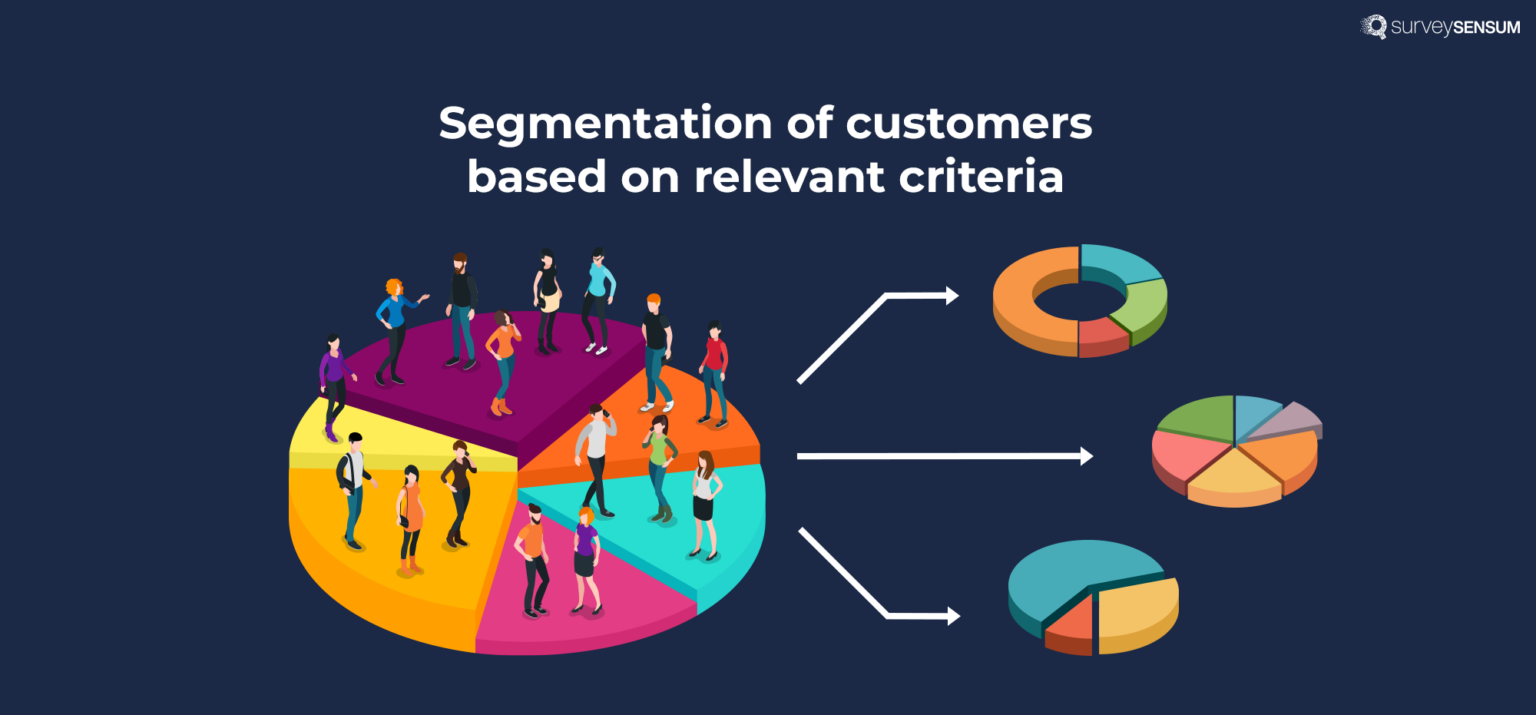
Why is it important?
Segmentation for surveys helps:
- Ensure higher survey response rates by sending relevant surveys to the right people.
- Improve data accuracy by eliminating irrelevant or untimely responses.
- Identify specific customer pain points and preferences for better decision-making.
- Identify high-value and low-value customers.
How to do it?
- Identify Your Target Audience – Focus on high-value customers essential to your business.
- Use Cluster Analysis & Define Segments – Group customers with similar traits for precise segmentation. And then, create customer personas based on shared characteristics.
- Use Segments for Marketing – Tailor marketing strategies and product offerings to each segment and adjust services to meet different customer needs for better results.
Now that we’ve covered the ABCs of segmentation, let’s dive into CRM-integrated email surveys and see how they can drive smarter customer interactions.
2. Boost Customer Engagement with CRM-Integrated Email Surveys
What is it?
CRM-integrated email surveys are automated surveys sent directly from your CRM system, allowing you to collect real-time, structured customer feedback. These surveys are linked to customer profiles, ensuring every response is captured and stored for deeper insights.
Why is it important?
- Eliminates manual follow-ups, saving time and resources.
- Maps responses to customer profiles, enabling deeper data analytics.
- Provides real-time customer sentiment tracking, helping teams react quickly.
- Enhances marketing and sales alignment by integrating feedback into CRM workflows.
How to do it?
1. Choose the Right Survey Tool – Use a CRM-compatible survey platform like SurveySensum, which integrates with Salesforce, HubSpot, or Zoho to automate survey distribution and collect responses in real-time.
2. Set Up Trigger-Based Surveys – Automate survey emails based on customer actions:
- After a purchase, ask about the buying experience.
- After customer support interactions, gauge satisfaction with issue resolution.
- After a subscription renewal or churn, understand loyalty or reasons for leaving.
Now that we’ve covered CRM-integrated email surveys, let’s dive into embedding surveys within customer portals and apps for a more integrated feedback experience.
3. Embedding Surveys in Customer Portals & Apps
What is it?
Embedded surveys are customer feedback forms that are seamlessly integrated into websites, emails, or mobile apps, allowing users to respond without being redirected to another page. Embedded surveys make feedback collection effortless and non-intrusive.
Why is it important?
- Increases survey response rates by engaging customers where they already interact.
- Provides instant feedback at key touchpoints, helping businesses optimize user experience.
- Captures customer preferences and behavioral trends to improve product/service offerings.
- Reduces friction by embedding surveys naturally into the customer journey.
How to do it?
1. Choose a Survey Tool with Embedding Capabilities – Use a platform like SurveySensum that allows seamless integration into websites, emails, and apps without disrupting the user experience.
2. Embed Surveys in Key Touchpoints – Place surveys where they naturally fit into the customer journey, be it on the website, customer portal, or app. Whether they’ve just made a purchase, explored a new feature, or checked their account, a well-placed survey captures insights when they matter most.
Having covered how to embed surveys in customer portals and apps, let’s now dive into automating surveys to nurture leads and boost customer retention effortlessly.
4. Automating Surveys for Lead Nurturing & Retention
What is it?
Rule-based survey automation that triggers feedback requests based on customer behavior and lifecycle events – like a recent purchase, a support ticket resolution, or a subscription renewal – to get insights when they matter most.
Why is it important?
With surveys automatically sent at key touchpoints, you can:
- Detects churn risks early, enabling proactive engagement and issue resolution.
- Monitor satisfaction trends to track sentiment, spot emerging trends, and refine your retention strategies.
- Ensures consistent data collection as every response feeds directly into your CRM, creating a real-time feedback loop.
- Boost efficiency – automates survey distribution and analysis, reducing manual effort while increasing response rates and data accuracy.
Right Survey, Right Time – Automate & Distribute Surveys Effortlessly with SurveySensum!
Now that we’ve covered how to structure and automate CRM surveys, let’s take it a step further and dive into how to analyze and measure that data – because collecting feedback is just the start.
How to Analyze & Leverage CRM Survey Data
CRM systems are your operational storytellers. While CRM tells you what happened, survey data explains why. By directly asking customers for feedback, survey data uncovers the feelings and motivations behind each interaction.
But it’s only valuable when you transform it into insights.
Let’s break down how to track, analyze, and use that data to power smart business moves.
1. Tracking & Measuring Key CRM Survey Metrics
Customer insights are built on CX metrics such as CSAT, NPS, and customer behavior patterns. They tell you what’s working and where you have to pivot, so you can close the feedback loop and act on trends in real-time.

SurveySensum provides you with all these metrics in an automated and innovative dashboard tied in a bow of insights. It displays real-time CSAT scores, customer sentiments, and behavior trends in a unified view. This AI-powered tool analyzes open-ended responses – helping you see the full picture of your customer journey without manual effort.
2. Identifying Trends & Actionable Customer Insights
When you look at your CRM survey results, it’s easy to see just a collection of data points. But each response tells a deeper story – whether it’s a glaring red flag or a subtle shift in sentiment. By analyzing numbers and open-ended feedback, you can uncover patterns, spot what keeps customers engaged, and address what’s pushing them away.

SurveySensum takes this a step further with AI-powered text analytics software. With it, you can automatically extract quantitative insights from unprocessed qualitative data in real-time, delivering top trends and sentiment metrics without the need for manual labor.
3. Optimizing Business Decisions Using Survey Data
Making business decisions without real insights is like driving in an unfamiliar city without GPS – you might get somewhere, but it’s probably not where you intended. Quick survey responses and basic data? They don’t dig deep enough to show you why customers walk away, what keeps them loyal, or what drives their engagement.
If you want to make smarter choices, you’ve got to dig into the REAL reasons behind customer satisfaction. Because, at the end of the day, those numbers? They only tell half the story. It’s the “why” behind them that truly fuels growth.
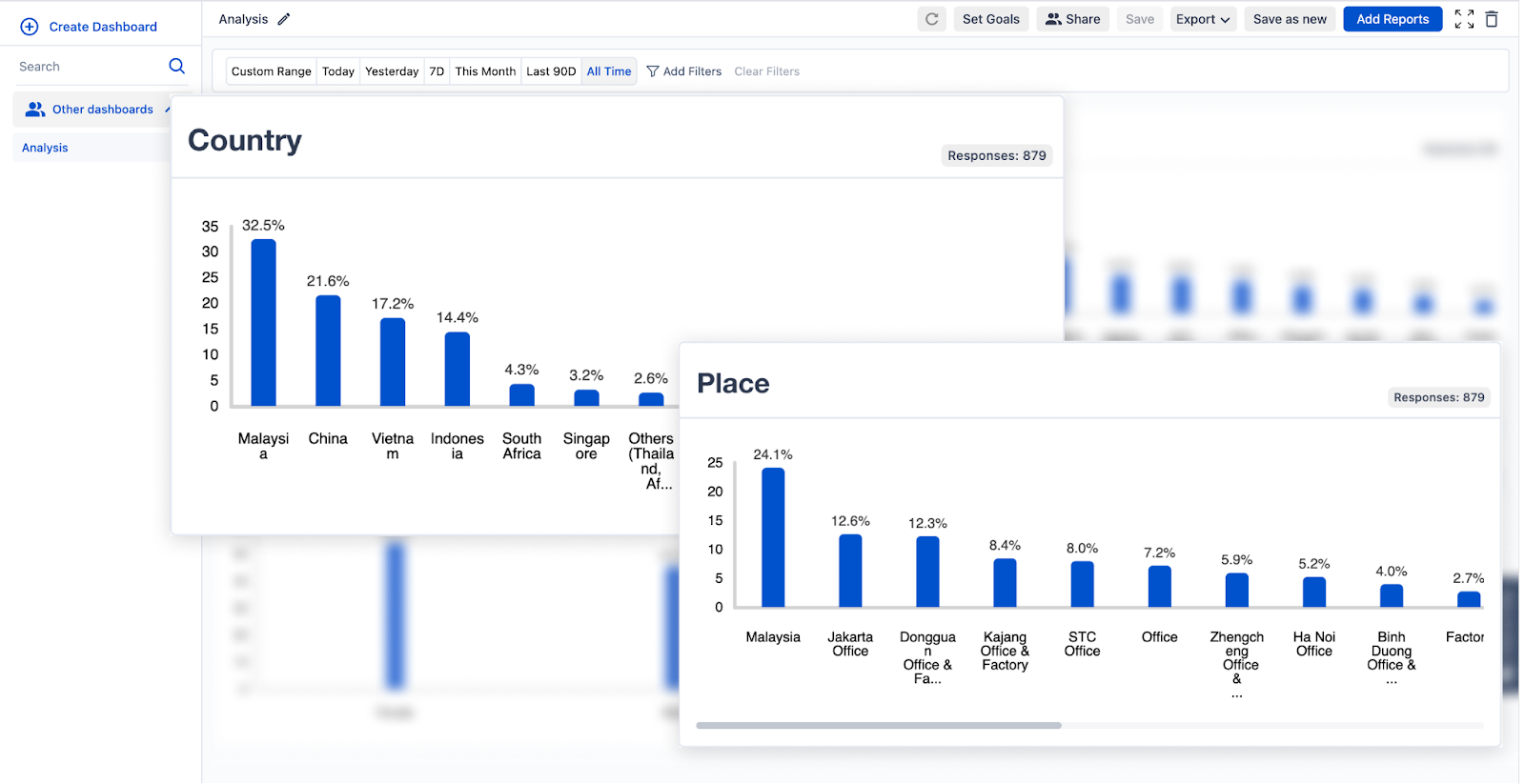
With SurveySensum’s cross-tabulation analysis, you can go beyond surface-level insights. By comparing responses across different customer groups, purchase behaviors, and time periods, you can identify patterns that standard reports might miss. This deep-dive approach helps pinpoint the exact key drivers influencing satisfaction or dissatisfaction.
4. Close the Feedback Loop
When customers raise concerns, don’t just collect feedback, act on it! Sure, not every comment needs an immediate response, but when it comes to negative feedback, speed matters. The faster you act, the stronger the trust. This closed-loop mechanism strengthens relationships, enhances the customer experience, and builds loyalty because people feel heard and valued.

With SurveySensum’s real-time ticketing system, you get an opportunity to enhance customer experience instantly. The system automates detractor alerts, assigns tickets to the right teams, and tracks resolution progress, ensuring that every response leads to meaningful action.
Automated alerts ensure that urgent issues get immediate attention, while progress tracking keeps resolutions on course. The result? Faster issue resolution, higher retention, and stronger brand loyalty.
Turn Insights into Action with SurveySensum – From Feedback to Faster Business Decisions!
Now that you understand how to analyze and leverage CRM survey data, let’s explore some expert-approved tips to implement these surveys effectively!
Best Practices for Sending CRM Surveys
1. Timing is Everything
Ask at the right moment, and you’ll get the best insights.
Here are a couple of golden rules:
- After onboarding, check in within a week to see how things are going.
- After a support interaction, send it within 24 hours while the experience is still fresh.
- Space your surveys wisely, thinking quarterly or monthly, to prevent survey fatigue.
- Aim for roughly 90 days out for renewals to receive timely comments before choices are taken.
2. Choosing the Right Survey Format
The goal is to strike a balance between structured insights and open-ended feedback. For clear, measurable insights, structured formats like multiple-choice and categorical questions work best. They make it easy to compare responses and identify trends.
- Standardize responses for easy analysis and trend identification, ensuring consistency across datasets.
- Use categorical options (e.g., age groups, job roles) to segment customers effectively for targeted insights.
- Reduce response fatigue by keeping answer choices concise and relevant, improving completion rates.
- When you need more profound insights, open-ended and rating scale questions help capture customer sentiment.
- Capture qualitative insights by allowing customers to share detailed feedback in their own words.
- Use rating scales (e.g., CSAT, NPS) to quantify satisfaction levels and benchmark trends over time.
Combine both formats for a well-rounded approach – structured data with contextual depth for better decision-making.
3. Make It Personal
- Use your CRM data to pre-fill details and reference past interactions.
- Tailor questions to different customer segments so each respondent feels uniquely understood.
- Customize follow-up questions based on initial answers – show you’re listening.
4. Keep It User-Friendly
- For mobile, utilize simple, straightforward language; for worldwide reach, provide multilingual options.
- Limit queries to the most basic and add visual progress markers to maintain pace.
By hitting these marks, you’ll boost response rates of your customer feedback surveys and gather higher-quality, actionable insights.
Wrapping Up
Like a championship-winning football team, CRM surveys demand strategy, accuracy, and the proper playbook to score big. See every response as a discourse rather than as a fact-based observation. Why would one stay with you? From what they are driving away? The solutions are right there; all you need is the correct tool to decipher them.
At that moment, SurveySensum takes on as your top player. Automated reporting, real-time dashboards, and AI-driven analysis enable it to cut through the noise. No fumbles, no wasted opportunities – just data-driven decisions that keep your business ahead of the competition.
Ready to bring your CX to the championship level? SurveySensum has your back covered.
Now that you know how to harness the power of CRM surveys, why wait? Turn insights into action today with SurveySensum!
Frequently Asked Questions
A CRM survey is a customer feedback survey integrated into a Customer Relationship Management (CRM) system. It helps businesses gather insights about customer satisfaction, preferences, and experiences to improve relationships and retention strategies.
CRM stands for Customer Relationship Management. It refers to strategies, technologies, and systems used by businesses to manage and analyze customer interactions throughout the customer lifecycle.
To create a CRM survey:
- Define your survey goals (e.g., customer satisfaction, service feedback, or product experience).
- Choose the right questions—mix rating scales, multiple-choice, and open-ended questions.
- Use a survey tool like SurveySensum to integrate the survey with your CRM system.
- Automate survey distribution at key customer touchpoints.
- Analyze responses and take action based on customer insights.






